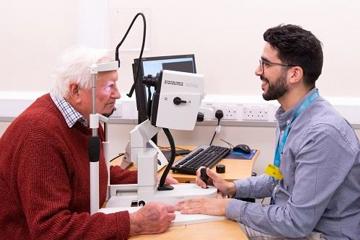Researchers at Moorfields Eye Hospital and UCL Institute of Ophthalmology (IoO) have developed an artificial intelligence (AI) system that has the potential to not only identify sight-threatening eye diseases but also to predict or identify other health conditions, including heart attacks, stroke, and Parkinson’s disease.
RETFound, one of the first AI foundation models in healthcare, and the first in ophthalmology, was developed using millions of eye scans from the NHS. The research team are making the system open-source and freely available to use by any institution worldwide, to act as a cornerstone for global efforts to detect and treat blindness using AI. This work has been published in Nature today.
A foundation model describes a very large, complex AI system, trained on huge amounts of data, which can be fine-tuned for a diverse range of subsequent tasks. RETFound consistently outperforms existing state-of-the-art AI systems across a range of complex clinical tasks, and even more importantly, it addresses a significant shortcoming of many current AI systems by working well in diverse populations, and in patients with rare disease.
Professor Pearse Keane, senior author, said: “This is another big step towards using AI to reinvent the eye examination for the 21st century, both in the UK and globally. We show several exemplar conditions where RETFound can be used, but it has the potential to be developed further for hundreds of other sight-threatening eye diseases that we haven’t yet explored.
“If the UK can combine high quality clinical data from the NHS, with top computer science expertise from its universities, it has the true potential to be a world leader in AI-enabled healthcare. We believe that our work provides a template for how this can be done.”
AI foundation models have come under the spotlight with the launch of foundation models such as ChatGPT, trained using vast quantities of text data to develop a versatile language tool. Taking a comparable approach with eye images, RETFound has been trained on millions of retinal scans to create a model that can be adapted for potentially limitless uses.
One of the key challenges when developing AI models is the need for data to be meticulously labelled and annotated, often expensive or time-consuming. RETFound can match the performance of other AI systems whilst using as little as 10 percent of human labels in its dataset.

In addition, RETFound has shown that it is equally effective in detecting disease across diverse populations. Yukun Zhou, lead author, says: "By training RETFound with datasets representing the ethnic diversity of London, we have developed a valuable base for researchers worldwide to build their systems in healthcare applications such as ocular disease diagnosis and systemic disease prediction."
RETFound could help improve diagnosis of some of the most debilitating eye diseases, including diabetic retinopathy and glaucoma, and predict systemic diseases such as Parkinson’s, stroke and heart failure.
The research team, led by Yukun Zhou and Pearse Keane of Moorfields and UCL IoO, have made the model freely available for use on GitHub. Researchers worldwide, such as Singapore and China, have been using RETFound in their novel investigation into eye diseases.
RETFound was trained with a curated dataset of 1.6 million images from Moorfields Eye Hospital, using AI tools and infrastructure provided by INSIGHT. The project was a collaboration between NIHR Moorfields, UCLH and NIHR Birmingham Biomedical Research Centres and brought together the Computer Science and Engineering teams at UCL.
13 September 2023